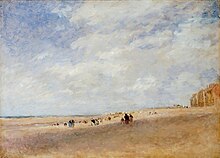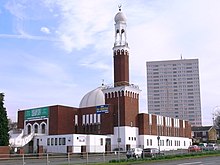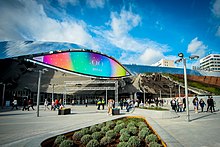Welcome to Visit Birmingham Places
The Walkfo guide to things to do & explore in Birmingham
![]() Visit Birmingham places using Walkfo for free guided tours of the best Birmingham places to visit. A unique way to experience Birmingham’s places, Walkfo allows you to explore Birmingham as you would a museum or art gallery with audio guides.
Visit Birmingham places using Walkfo for free guided tours of the best Birmingham places to visit. A unique way to experience Birmingham’s places, Walkfo allows you to explore Birmingham as you would a museum or art gallery with audio guides.
Visiting Birmingham Walkfo Preview
Birmingham is the second-largest city, urban area and metropolitan area in England and the United Kingdom . It is located in the West Midlands county and region in England, approximately 100 miles (160 km) from Central London . Historically a market town in Warwickshire in the medieval period, Birmingham grew during the 18th century during the Midlands Enlightenment and during the Industrial Revolution . The Watt steam engine was invented in Birmingham . When you visit Birmingham, Walkfo brings Birmingham places to life as you travel by foot, bike, bus or car with a mobile phone & headphones.
Birmingham Places Overview: History, Culture & Facts about Birmingham
Visit Birmingham – Walkfo’s stats for the places to visit
With 451 audio plaques & Birmingham places for you to explore in the Birmingham area, Walkfo is the world’s largest heritage & history digital plaque provider. The AI continually learns & refines facts about the best Birmingham places to visit from travel & tourism authorities (like Wikipedia), converting history into an interactive audio experience.
Birmingham history
Pre-history and medieval
There is evidence of early human activity in the Birmingham Plateau dating back to around 8000 BC . Stone Age artefacts suggest seasonal settlements, overnight hunting parties and woodland activities such as tree felling . The development of Birmingham into a significant urban and commercial centre began in 1166 . By 1327 it was the third-largest town in Warwickshire .
Early modern
By 1700 Birmingham’s population had increased fifteen-fold and the town was the fifth-largest in England and Wales . The importance of the manufacture of iron goods to Birmingham’s economy was recognised as early as 1538 . By the 1600s Birmingham formed the commercial hub of a network of forges and furnaces stretching from South Wales to Cheshire .
Industrial Revolution

Birmingham’s explosive industrial expansion started earlier than that of the textile-manufacturing towns of the North of England . Instead of the economies of scale of a low-paid, unskilled workforce producing a single bulk commodity such as cotton or wool in large, mechanised units of production . Birmingham residents registered over three times as many patents as those of any other British town or city .
Regency and Victorian

Birmingham rose to national political prominence in the campaign for political reform in the early 19th century . Thomas Attwood and the Birmingham Political Union brought the country to the brink of civil war during the Days of May that preceded the passing of the Great Reform Act in 1832 . Birmingham was the terminus for the world’s first two long-distance railway lines .
20th century and contemporary

The city suffered heavy bomb damage during World War II’s “Birmingham Blitz” The city was also the scene of two scientific discoveries that were to prove critical to the outcome of the war . The city’s population peaked in 1951 at 1,113,000 residents . 21 people were killed and 182 injured in a series of bomb attacks in 1974 thought to be carried out by the Provisional IRA .
Birmingham culture & places
Music

The City of Birmingham Symphony Orchestra’s home venue is Symphony Hall . Elgar’s The Dream of Gerontius had its début performance there in 1900 . Birmingham was the birthplace of modern bhangra in the 1960s . The city was a centre for early heavy metal music, with pioneering metal bands from the late 1960s and 1970s such as Black Sabbath .
Theatre and performing arts

Birmingham Repertory Theatre is Britain’s longest-established producing theatre . The Alexandra Theatre and the Birmingham Hippodrome host large-scale touring productions . Professional drama is performed on a wide range of stages across the city . The Glee Club is the first dedicated comedy club outside of London .
Literature

Literary figures associated with Birmingham include Samuel Johnson and Washington Irving . W. H. Auden grew up in the Harborne area of the city and formed the core of the Auden Group with Birmingham University lecturer Louis MacNeice . The award-winning political playwright David Edgar was born in Birmingham .
Art and design

Birmingham was an important centre of Victorian art, particularly within the Pre-Raphaelite and Arts and Crafts movements . Surrealists were among the “harbingers of surrealism” in Britain in the 1930s . Peter Phillips was among the central figures in the birth of Pop Art .
Museums and galleries

Birmingham Museum & Art Gallery is best known for its works by the Pre-Raphaelites . The Barber Institute of Fine Arts in Edgbaston is one of the finest small art galleries in the world . Thinktank is Birmingham’s main science museum, with a giant screen cinema, a planetarium and a collection that includes the Smethwick Engine .
Nightlife and festivals

Nightlife in Birmingham is mainly concentrated along Broad Street and into Brindleyplace . Outside the city centre is Star City entertainment complex on former site of Nechells Power Station . The city’s largest single-day event is its St. Patrick’s Day parade (Europe’s second largest, after Dublin)
Food and drink

Birmingham is the only city outside London to have five Michelin-starred restaurants . Birmingham Wholesale Markets are the largest combined wholesale food markets in the country . The Balti, a type of curry, was invented in the city, which has received much acclaim for the ‘Balti Belt’ The Wing Yip food empire began in Birmingham and now has its headquarters in Nechells .
Entertainment and leisure
Birmingham is home to Europe’s largest leisure and entertainment complex Star City . Europe’s first out-of-city-centre entertainment complex Resorts World Birmingham is owned by the Genting Group .
Architecture

There are 1,946 listed buildings in Birmingham and thirteen scheduled ancient monuments . Traces of medieval Birmingham can be seen in the oldest churches, notably the original parish church, St Martin in the Bull Ring . A few other buildings from the medieval and Tudor periods survive, among them the Lad in the Lane and The Old Crown .
Demonymy and identity
People from Birmingham are called Brummies, a term derived from the city’s nickname of “Brum” The Brummie accent and dialect are particularly distinctive .
Birmingham etymology
The name Birmingham comes from the Old English Beormingahām, meaning “Beormingas” The name means the home or settlement of a tribe or clan which may have formed an early unit of Anglo-Saxon administration. Beorma could have been its leader at the time of the settlement, a shared ancestor, or a mythical tribal figurehead.
Birmingham geography / climate

Birmingham is located in the centre of the West Midlands region of England on the Birmingham Plateau. The city is drained only by minor rivers and brooks, primarily the River Tame and its tributaries the Cole and the Rea. The City of Birmingham forms a conurbation with the largely residential borough of Solihull to the south east, and with the city of Wolverhampton and the industrial towns of the Black Country to the north west.
Geology
Birmingham is dominated by the Birmingham Fault, which runs diagonally through the city from the Lickey Hills in the south west . To the south and east of the fault the ground is largely softer Mercia Mudstone, interspersed with beds of Bunter pebbles and crossed by valleys of the Rivers Tame, Rea and Cole and their tributaries .
Climate
Birmingham has a temperate maritime climate, like much of the British Isles, with average maximum temperatures in summer (July) and in winter (January) around 6.7 °C (44.1 °F) Between 1971 and 2000 the warmest day of the year on average was 28.8 °C and the coldest night typically fell to −9.0 °C . Extreme weather is rare, but the city has been known to experience tornadoes .
Environment

There are 571 parks within Birmingham – more than any other European city – totalling over 3,500 hectares (14 sq mi) of public open space . The city has over six million trees, and 250 miles (400 km) of urban brooks and streams . Sutton Park, which covers 2,400 acres (971 ha) in the north of the city, is the largest urban park in Europe and a national nature reserve .
Why visit Birmingham with Walkfo Travel Guide App?
![]() You can visit Birmingham places with Walkfo Birmingham to hear history at Birmingham’s places whilst walking around using the free digital tour app. Walkfo Birmingham has 451 places to visit in our interactive Birmingham map, with amazing history, culture & travel facts you can explore the same way you would at a museum or art gallery with information audio headset. With Walkfo, you can travel by foot, bike or bus throughout Birmingham, being in the moment, without digital distraction or limits to a specific walking route. Our historic audio walks, National Trust interactive audio experiences, digital tour guides for English Heritage locations are available at Birmingham places, with a AI tour guide to help you get the best from a visit to Birmingham & the surrounding areas.
You can visit Birmingham places with Walkfo Birmingham to hear history at Birmingham’s places whilst walking around using the free digital tour app. Walkfo Birmingham has 451 places to visit in our interactive Birmingham map, with amazing history, culture & travel facts you can explore the same way you would at a museum or art gallery with information audio headset. With Walkfo, you can travel by foot, bike or bus throughout Birmingham, being in the moment, without digital distraction or limits to a specific walking route. Our historic audio walks, National Trust interactive audio experiences, digital tour guides for English Heritage locations are available at Birmingham places, with a AI tour guide to help you get the best from a visit to Birmingham & the surrounding areas.
“Curated content for millions of locations across the UK, with 451 audio facts unique to Birmingham places in an interactive Birmingham map you can explore.”
Walkfo: Visit Birmingham Places Map
451 tourist, history, culture & geography spots
Birmingham historic spots | Birmingham tourist destinations | Birmingham plaques | Birmingham geographic features |
| Walkfo Birmingham tourism map key: places to see & visit like National Trust sites, Blue Plaques, English Heritage locations & top tourist destinations in Birmingham | |||
Best Birmingham places to visit
Birmingham has places to explore by foot, bike or bus. Below are a selection of the varied Birmingham’s destinations you can visit with additional content available at the Walkfo Birmingham’s information audio spots:
 | Chamberlain Memorial The Chamberlain Memorial is a monument in Chamberlain Square, Birmingham . It was erected in 1880 to commemorate the public service of Joseph Chamberlain . Chamberlain was a Birmingham businessman, councillor, mayor, Member of Parliament, and statesman . |
 | Omega Sektor Omega Sektor was a computer gaming centre brand . One smaller venue was based in Harrow, the other on Corporation Street in Birmingham . The Birmingham venue claimed to be the largest of its kind in Europe . |
 | Chinese Quarter, Birmingham The Chinese Quarter of Birmingham is located in the city centre’s Southside . It is an area with a predominantly Chinese influence as a result of a concentration of Chinese owned businesses . The area now covers a neighbourhood that includes Hurst Street, Ladywell Walk and Pershore Street . |
 | Highgate, Birmingham Highgate is the site of the original Anglo-Saxon settlement which gave the city of Birmingham its name . Following the Big City Plan of 2008, Highgate has become a district of Birmingham City Centre . |
 | Deritend Deritend is a historic area of Birmingham, England, built around a crossing point of the River Rea . It was first mentioned in 1276 and is usually considered to be part of Digbeth . |
 | Theatre Royal, Birmingham The Theatre Royal, until 1807 the New Street Theatre, or, colloquially the New Theatre, was a 2000-seat theatre located on New Street in Birmingham, England . It was erected in 1774 and demolished in 1956 . |
 | Frankfurt Christmas Market, Birmingham Frankfurt Christmas Market and Craft Market is held in central Birmingham, England . The market started in 2001 with 24 stalls and has expanded every year . It opens in mid November and continues until late December, closing before Christmas . |
 | Victoria Square House Victoria Square House, is an office building on the south side of Victoria Square, Birmingham, England . It was formerly Birmingham’s Head Post Office, designed in the French Renaissance style by architect Henry Tanner for the General Post Office . |
 | Christ Church, Birmingham Christ Church, Birmingham, was a parish church in the Church of England on Colmore Row, Birmingham from 1805 to 1899 . Christ Church was a church in Birmingham from the 1805-1899 period . |
 | Gosta Green Gosta Green lies at the edge of the city centre, 3/4 mile (1.2 km) northeast of Birmingham New Street station . |
Visit Birmingham plaques
![]() 213
213
plaques
here Birmingham has 213 physical plaques in tourist plaque schemes for you to explore via Walkfo Birmingham plaques audio map when visiting. Plaques like National Heritage’s “Blue Plaques” provide visual geo-markers to highlight points-of-interest at the places where they happened – and Walkfo’s AI has researched additional, deeper content when you visit Birmingham using the app. Experience the history of a location when Walkfo local tourist guide app triggers audio close to each Birmingham plaque. Explore Plaques & History has a complete list of Hartlepool’s plaques & Hartlepool history plaque map.
